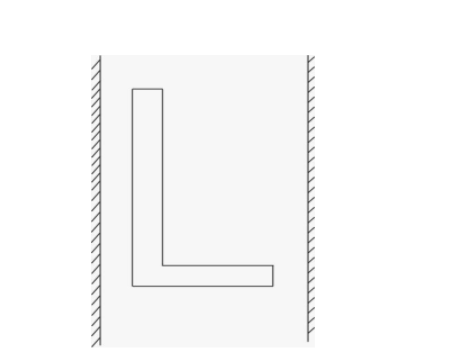
An object shaped as L is placed between two parallel plane mirrors as shown. In the first seven closest images, how many laterally inverted images are formed?

(A) 1
(B) 2
(C) 3
(D) 4
Answer
216.6k+ views
Hint The phenomenon in plane mirrors in which our left is appeared as right and right is appeared as left is known as lateral inversion. The images formed by such inversion are known as laterally inverted images.
Step by step solution
Now first we will draw seven images of the object ( as per given in question)

Due to the object L, Images $I_1$ and $I_2$ are formed.
Now image \[\mathop I\nolimits_1 \] acts as object 2 for mirror 2 and produces image $I_4$. Similarly, image \[\mathop I\nolimits_2 \]acts as an object 1 for mirror 1 and produces image $I_3$. Now image \[\mathop I\nolimits_3 \] will act as an object for mirror 1 and produce images \[\mathop I\nolimits_4 \] and the process will continue till the formation of 7 images. When these images first act as an object they produce non – laterally inverted images.
Thus, by counting in figure, we conclude there are four laterally inverted images.
Now let us match the calculated and with the options given
1 :- This value does not match with the value that comes from calculation. Hence this option is not correct.
2 :- This value does not match with the value that comes from calculation. Hence this option is not correct.
3 :- this number matches with the value of non-lateral images produced and hence this option is not correct.
4 :- this value exactly matches with the number of laterally inverted images produced. Hence this option is correct.
Our required answer is d that is 4
Note
Plane mirror always produces virtual and erect images. The size of the image is always equal to that of the object. The image formed is as far behind the mirror as the object is in front of it. The images are laterally inverted.
Step by step solution
Now first we will draw seven images of the object ( as per given in question)

Due to the object L, Images $I_1$ and $I_2$ are formed.
Now image \[\mathop I\nolimits_1 \] acts as object 2 for mirror 2 and produces image $I_4$. Similarly, image \[\mathop I\nolimits_2 \]acts as an object 1 for mirror 1 and produces image $I_3$. Now image \[\mathop I\nolimits_3 \] will act as an object for mirror 1 and produce images \[\mathop I\nolimits_4 \] and the process will continue till the formation of 7 images. When these images first act as an object they produce non – laterally inverted images.
Thus, by counting in figure, we conclude there are four laterally inverted images.
Now let us match the calculated and with the options given
1 :- This value does not match with the value that comes from calculation. Hence this option is not correct.
2 :- This value does not match with the value that comes from calculation. Hence this option is not correct.
3 :- this number matches with the value of non-lateral images produced and hence this option is not correct.
4 :- this value exactly matches with the number of laterally inverted images produced. Hence this option is correct.
Our required answer is d that is 4
Note
Plane mirror always produces virtual and erect images. The size of the image is always equal to that of the object. The image formed is as far behind the mirror as the object is in front of it. The images are laterally inverted.
Recently Updated Pages
Wheatstone Bridge Explained: Working, Formula & Uses

Young’s Double Slit Experiment Derivation Explained

JEE Atomic Structure and Chemical Bonding important Concepts and Tips

JEE Amino Acids and Peptides Important Concepts and Tips for Exam Preparation

Electricity and Magnetism Explained: Key Concepts & Applications

Chemical Properties of Hydrogen - Important Concepts for JEE Exam Preparation

Trending doubts
JEE Main 2026: Application Form Open, Exam Dates, Syllabus, Eligibility & Question Papers

Derivation of Equation of Trajectory Explained for Students

Hybridisation in Chemistry – Concept, Types & Applications

Understanding the Angle of Deviation in a Prism

Understanding Collisions: Types and Examples for Students

How to Convert a Galvanometer into an Ammeter or Voltmeter

Other Pages
JEE Advanced Marks vs Ranks 2025: Understanding Category-wise Qualifying Marks and Previous Year Cut-offs

Understanding Atomic Structure for Beginners

Ideal and Non-Ideal Solutions Explained for Class 12 Chemistry

Degree of Dissociation: Meaning, Formula, Calculation & Uses

Understanding Electromagnetic Waves and Their Importance

Understanding the Electric Field of a Uniformly Charged Ring




